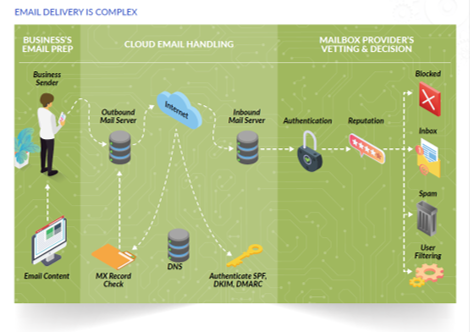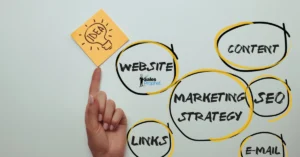There are over 4.3 billion email users worldwide in 2023!
For many years now, most marketers will tell you that B2B mass email doesn’t work. They will tell you that no one wants prospecting emails and that you will only destroy your email reputation and brand by via mass email. These are the same people who have adopted an inbound marketing strategy telling the world it’s the only way to go.
Meanwhile, these people seem to have no problem with the huge spikes in cost-per-click campaigns and online advertising. They don’t seem to mind letting Google take control of their marketing destiny.
I’m here to tell you that these people couldn’t be more wrong about mass email. They just haven’t figured out how to use mass email correctly. Nor have they figured out how to maintain a strong email reputation and strong delivery into the inbox of their target audience.
In 2022, the number of email users worldwide reached over 4 billion. This figure is set to grow to 4.6 billion in 2025, making up more than half of the expected world population. In 2022 alone, 333.2 billion emails were sent and received each day (Statista, 2021).
That’s a staggering number of daily emails.
That’s not all. This figure is also expected to increase to over 375 billion by 2025. This email marketing statistic demonstrates that email marketing is a key part of all successful multi-channel marketing campaigns. In fact, the importance of email is growing.
However, email marketing is not without its challenges. Competition in the inbox is stiff, and getting noticed starts with having a relevant message that resonates with your target customer. Without a relevant message, your email is more likely to be seen as spam, and not only will it not be delivered to the inbox, but it can also damage your overall email-sending reputation and brand.
Why should I consider mass email?
For every $1 you spend on email marketing, you can expect an average return of anywhere between $35-$45. Email marketing has the highest ROI of any marketing channel.
The latest statistics show that as many as 87% of marketers use email marketing to proactively place their content in the hands of their customers (Content Marketing Institute, 2020).
The benefit of adding this proactive channel to your marketing campaigns is that it will reinforce the messaging you are driving through your paid media (display, social media, and search) and organic (SEO) channels, thus amplifying your brand awareness and customer acquisition activities.
Email marketing offers many benefits as a content distribution channel that marketers aren’t just using organically—one-third of them are also engaging in paid collaborations to promote their content to their partners’ email databases.
In fact, email is so popular among marketers that email engagement is one of the top metrics to evaluate content performance. 86% of marketers say they look at email engagement metrics such as open rates, click rates, and downloads to determine how successful a piece of content is, more so than website traffic and social media analytics.
So why are so many people choosing inbound marketing over outbound?
We suspect it’s because they don’t fully understand how email works. If they understood the role email marketing could play in their multi-channel marketing success, they would certainly be using more mass email in their marketing strategy.
How does email work?

Let’s say you created an email you want to send to a particular person or list of contacts. That email is sent through an outbound mail server, which is connected to the internet, which is connected to the contacts inbound mail server. Before that inbound mail server accepts your email, it verifies your information and authenticates this email before agreeing to deliver it to the contact you are trying to reach.
This authentication process will also look at your email reputation and, in some cases, see if your email is listed as a potential spammer or threat. Depending on your email reputation, the inbound mail server decides where to deliver your email, i.e., inbox, spam folder or not at all (Blocked).
The illustration above is a simple visualization of the sending process.
We go into great detail on how to verify and prepare your email data to ensure good deliverability here.
This verification process has been very effective at blocking unwanted email from nefarious senders,
but it has also impacted permission-based marketers in the process.
Also, most marketers today use a third-party email or marketing automation platform. One problem with these platforms is they will send your email over a single pool of IPs. As a result, many email platforms will not allow their users to send mass email campaigns.
Why?
Because these platforms combine multiple customers over their pool of IPs and mail servers. Therefore, a single customer could damage the sending reputation of everyone on that same mail server or bank of IP addresses used to send email.
It only takes one bad actor to do one of the following things to impact everyone using that mail server:
Bad/hard-bounced emails – A high number of emails were sent to bad email addresses, causing a high number of hard bounces (permanent failures). This tells Email Service Providers (ESP), and Internet Service Providers (ISP) that this company has not verified their data. Hard bounces lead to lower IP and domain reputation at the ISP level, in turn damaging the ESP IP pool and other mailers using those IPs.
Poor Engagement – The emails being sent by this company are getting low open rates and/or clicks (Engagement). This tells the ESPs that these emails are not wanted and could be considered unsolicited or SPAM.
Poor Email Reputation – The emails being sent by this company have been flagged as spam by users, or their content includes spam words, or their email volume is suddenly extremely high (unusual traffic patterns).
When these scenarios happen, it can cause blacklist companies (i.e., Spamhaus, Spamcop, Barracuda) to list your email domain or IP address(s) as suspect, impacting your ability to get an email delivered to your prospects’ inbox.
Getting removed from a blacklist is very costly and time-consuming. It can take a significant amount of effort to rebuild your email-sending reputation, which translates into poor deliverability and lost sales.
How Do You Avoid This from Happening?
The first step in optimizing your email campaign is to take control over how your email is sent. By selecting an email platform that enables you to leverage multiple SMTPs, you can optimize delivery rates across multiple IP Pools.
Remember, not all SMTPs will have the same inbox success rate for each email provider (Gmail, Yahoo, iCloud, Comcast, etc.).
This is why Sales Prophet went through the integration and security audits for the top email providers and integrated with the three top SMTP providers: SparkPost, SendGrid, and Mailgun.
What is SMTP?
SMTP, or Simple Mail Transfer Protocol, is an application that is used to send, receive, and relay outgoing emails between senders and receivers. When an email is sent, it’s transferred over the internet from one server to another using SMTP. The SMTP relay service can be used to resolve a lot of issues, such as email deliverability and IP reputation.
There are several other protocols that are used for mail retrieval, the process of retrieving email stored on a mail server. The most common ones are Post Office Protocol Version 3 (POP3) and Internet Message Access Protocol (IMAP).
POP/IMAP is suitable for only email retrieval.
An SMTP client and SMTP server can stand alone on an outbound-only mail server, but POP and IMAP servers are useless on their own; they need to be paired with a mail server that pulls the SMTP and POP/IMAP protocols together.
Taking Control of How Your Email Is Sent
Instead of relying on the single SMTP provider that your email application provides, by picking a email platform that has multiple SMTP providers, you can take control of how your email is sent and delivered.
Again, this is why Sales Prophet has added direct connection to three SMTP providers and added several sending options regarding the volume of emails being sent over x amount of time.
Example:
Let’s say you are sending 100,000 emails a week. By having three SMTP providers connected to your email platform, you can route a third of your list across three different SMTP providers and reduce the size of your campaigns and the risk associated with that large campaign.
In a worst-case scenario, you get a high number of spam complaints reported to one of your SMTP providers and can shut down your ability to send any more emails. You can investigate the issue, fix it, and reroute your emails through another SMTP provider to complete the campaign.
Not to mention the fact all your digital assets, including the contacts you want to reach, remain in Sales Prophet, allowing you to continue your marketing campaign with less outage time, sales loss, and cost.
If you are sending higher volumes of email, you can take this a step further and buy several IP addresses associated with each SMTP provider and route your email sends through both multiple SMTP’s and IP addresses.
Email Marketing Best Practices
Regardless of your email platform or the SMTP providers and IP addresses you use, at the end of the day, you need to manage your sending reputation. This reputation, which can be at the IP or domain level, will play a large role in how well your emails are delivered to your customer’s or prospect’s inbox.
To actively manage your reputation across SMTPs, IPs, and sub-domains/domains, you should focus on your core email metrics (soft bounces, hard bounces, opens, clicks, and complaints). Otherwise, you risk wasting a lot of time and hard work creating relevant and compelling content that very few will see because it’s sitting in a spam folder.
Note: Open and click tracking has become very difficult to track accurately due to Apple’s Mail Privacy Protection policy. If your customer or prospect has connected their email account to the Apple Mail app for iPhone, iPad, Mac computers, or Apple Watch and has Protect Mail Activity turned on, you will get what we call false positive reporting. This means your open reports will show an open when the email was never opened.
So, your open rate reports will be inflated. If you exclude the Apple proxies from your reporting, then you are under-reporting.
Sales Prophet is working on giving our users the option to include or exclude Apple proxies for more accurate reporting.
The Role Mass Email Plays in Demand Generation
A core component of your Demand Generation strategy is to establish your company as a helpful thought leader in the industry. You do this by creating compelling content that ultimately generates qualified leads and, thus, in turn, profitable top-line sales growth.
Our experience shows that prospects dont mind receiving unsolicited emails as long as the content is relevant.
This is why we recommend developing relevant industry guides and insightful research in your mass email marketing strategies.
Using mass email, you can get these guides and research studies directly into the hands of your ideal prospects at ideal companies.
For example, we sent approximately 300,000 emails targeting HR contacts at companies with more than 500 employees in certain industries. We drove more traffic to our customer’s website than any other marketing channel (for a fraction of the cost of their paid media channels) and generated more leads than any other campaign in their history.
These mass email campaigns started with the right content (research studies) being sent to ideal contacts in the Sales Prophet database who would find this information relevant. We personalized and segmented the campaigns for each persona typically involved in a buying process.
The people who received these emails viewed the content as relevant, and as a result, we had only three spam complaints out of 300,000 emails and had less than 0.01% unsubscribe rate.
Summary
As you develop your multi-channel marketing campaigns, be sure to leverage mass email to target your ideal prospects based on your ideal customer profile (ICP).
We get into more detail about developing an ICP here if you need help.
Verify your email addresses before launching your campaign. If you need more information about email verification, please check out our Definitive Guide to Email Verification.
Make sure to properly set up your domain records for SPF, DKIM nad DMARC.
We have a complete guide on how to set up proper spf, dkim and dmarc records here if you need help.
Send helpful thought leadership content in the forms of guides, research papers, industry studies, etc. (Not promotional offers—leave those to people who have already expressed interest in your products and services).
Remember: prospects don’t mind if you send them an unsolicited email if it is relevant and helpful.
Pick an email platform like Sales Prophet that will give you control over how your email is sent using multiple SMTP and email accounts.
Pay attention to your open and click-through rates to monitor your engagement. If you can, look at your open reports with and without Apple proxies to get a sense of your real open rates.
Set up A/B/C test splits to find out what subject lines get the best open rates and what content gets the best click-through rates.
Remember only to use helpful thought leadership content to improve your relevancy.




